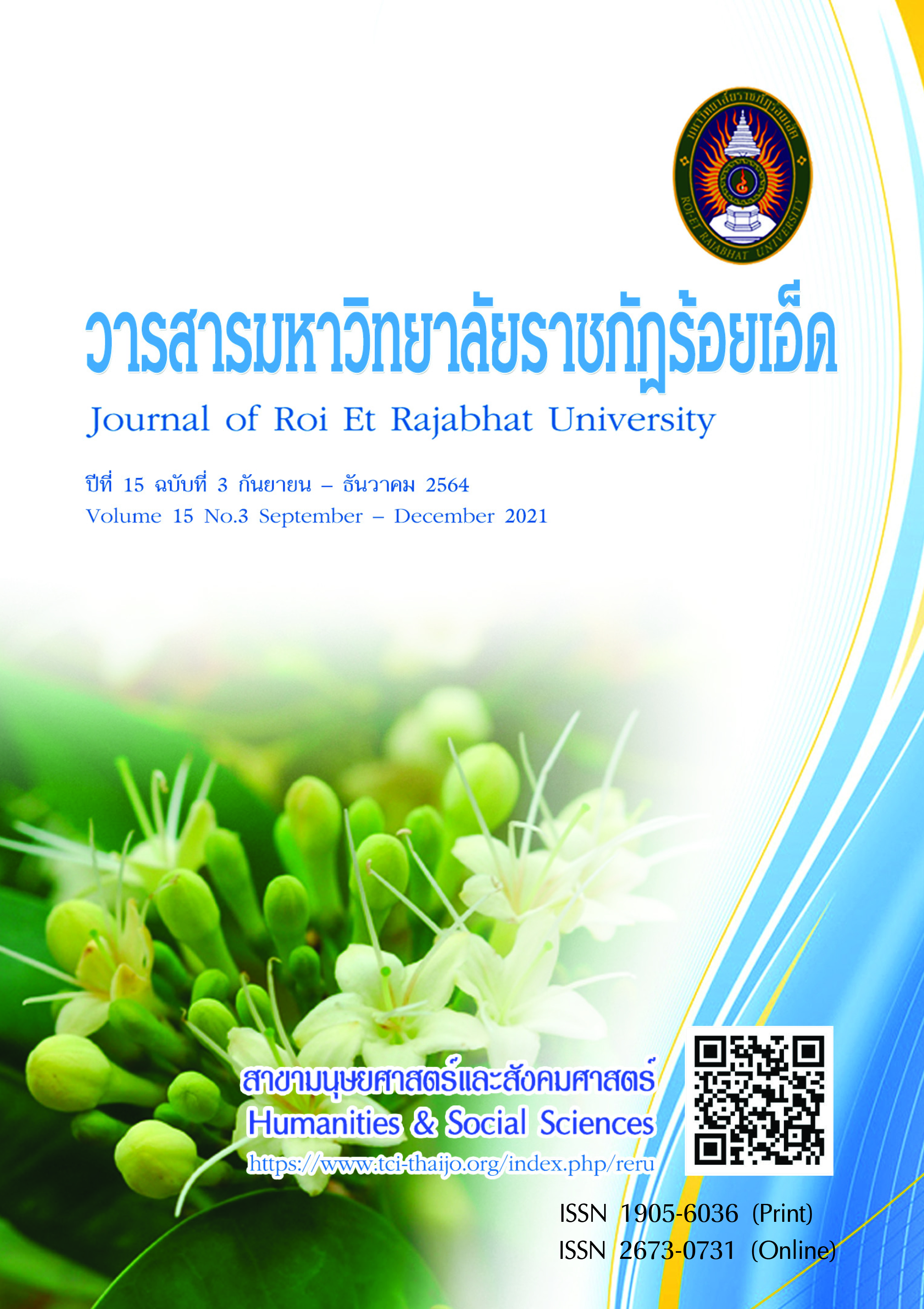Guideline for Development at Khwao Sinarin Silver Handicrafts Village to Support Cultural Tourism in Surin Province
Keywords:
Guideline for development, Silver handicrafts, Cultural tourismAbstract
The purposes of this research were to study tourism resources, study the potential of cultural tourism of Khwao Sinarin Silverware Group and guide the way of development to support cultural tourism of Surin Province. 2 sample groups were 20 stakeholders and 400 Thai tourists. The research instruments were in-depth interview form, questionnaire and descriptive analysis. Statistics used in data analysis were mean, percentage, and standard deviation. The result of the research found that Tourism resources in the area of Khwao Sinarin handicraft group. The uniqueness of the community is the production process Including silk handicrafts, local food and desserts. The potential of cultural tourism found that the opinions were at high level. The aspect of the tourist attractions had the highest average opinion on the identity, culture, traditional way of life of the locality and there are silverware products for selling to tourists. The aspect of the accommodation, the most guests were government agencies. And the guidelines for the development of Khwao Sinarin Silver Handicraft group should begin with creating understanding to realize the importance of tourism occurring in the community. After that, creating public relations strategies for tourist attractions together with activity development and tourists can participate in activities. Meanwhile, the government need to contribute the budget and knowledge for preparing to support cultural tourism with an emphasis on the participation of all sectors in effective and sustainable management.
References
การท่องเที่ยวแห่งประเทศไทย. (2560). โครงการทิศทางการพัฒนาท่องเที่ยวของประเทศไทยในระยะ 10 ปี. สืบค้นเมื่อ
พฤษภาคม 2560, จาก ้https://secretary.mots.go.th/ewtadmin/ewt/policy/article_attach/02FinalReportDirection10Year.pdf
กระทรวงการท่องเที่ยวและกีฬา. (2562). รายงานภาวะเศษฐกิจการท่องเที่ยว. สืบค้นเมื่อ 28 มีนาคม 2562, จาก https://www.mots.go.th/download/a rticle/ article_20191025094442.pdf
บุญชม ศรีสะอาด. (2545). การวิจัยเบื้องต้น (พิมพ์ครั้งที่ 7). กรุงเทพฯ: สุวีริยาสาส์น.
เบญจมาศ ณ ทองแก้ว, อำนาจ รักษาพล, จุฑามาศ เพ็งโคนา และบุญศิลป์ จิตตะประพันธ์. (2560). ศักยภาพและแนวทางการพัฒนาแหล่งท่องเที่ยวตำบลคันธุลี จังหวัดสุราษฎร์ธานี. วารสารวิจัยเพื่อการพัฒนาเชิงพื้นที่, 9(2), 106-121.
ปิยธิดา หงส์ศรี. (2560). แนวทางในการพัฒนาศักยภาพการท่องเที่ยว ถนนคนเดินอำเภอเขมราฐ จังหวัดอุบลราชธานี. วิทยานิพนธ์ ศิลปศาสตรมหาบัณฑิต สาขาวิชาการจัดการการท่องเที่ยวและโรงแรม. มหาสารคาม: มหาวิทยาลัยมหาสารคาม.
ลินจง โพชารี. (2559). รายงานการวิจัยการจัดการท่องเที่ยวของชุมชนสะพานไม้แกดำ ตำบลแกดำ อำเภอแกดำ จังหวัดมหาสารคาม. มหาสารคาม: มหาวิทยาลัยมหาสารคาม.
วิตติกา ทางชั้น. (2557). การพัฒนาตัวชี้วัดการท่องเที่ยวเชิงวัฒนธรรมอีสานริมชายแดนโขงสู่ความยั่งยืน. ดุษฎีนิพนธ์ ปรัชญาดุษฎีบัณฑิต สาขาวิชาการจัดการนวัตกรรมการท่องเที่ยวและการจัดการ. ขอนแก่น: มหาวิทยาลัยขอนแก่น.
วีระพล ทองมา. (2559). การท่องเที่ยวโดยชุมชน (Community Based Tourism :CBT) สำหรับการพัฒนาคุณภาพชีวิตของชุมชนในเขตที่ดินป่าไม้. สืบค้นเมื่อ 16 ธันวาคม 2562, จาก www.dnp.go.th/ fca16/file/i49xy4ghqzsh3j1.doc
สำนักงานสถิติจังหวัดสุรินทร์. (2559). สถิตินักท่องเที่ยวจังหวัดสุรินทร์ ประจำปี 2559. สืบค้นเมื่อ 17 มกราคม 2561,
จาก http://surin.old.nso.go.th/nso/project/search_option/index.jsp?province_id=76
องค์การบริหารส่วนจังหวัดสุรินทร์. (2557). ของที่ระลึก. สุรินทร์: องค์การบริหารส่วนจังหวัดสุรินทร์.
อภิวัตน์ ภูริศิวารักษ์. (2558). การจัดการท่องเที่ยวโดยชุมชน ศึกษาพื้นที่บ้านฝั่งท่า หมู่ 5 ตำบลวังก์พง อำเภอปราณบุรี จังหวัดประจวบคีรีขันธ์. วิทยานิพนธ์ ศิลปศาสตรมหาบัณฑิต สาขาวิชาชนบทศึกษาและการพัฒนา. กรุงเทพฯ: มหาวิทยาลัยธรรมศาสตร์.
Krejcie, R.V. and Morgan, D.W. (1970). Determining Sample Size for Research Activities. Educational and Psychological Measurement, 30(3), 607-610.
Downloads
Published
How to Cite
Issue
Section
License
บทความที่ได้รับการตีพิมพ์เป็นลิขสิทธิ์ของวารสารมหาวิทยาลัยราชภัฎร้อยเอ็ด
ข้อความที่ปรากฏในบทความแต่ละเรื่องในวารสารวิชาการเล่มนี้เป็นความคิดเห็นส่วนตัวของผู้เขียนแต่ละท่านไม่เกี่ยวข้องกับมหาวิทยาลัยราชภัฎร้อยเอ็ด และคณาจารย์ท่านอื่นๆในมหาวิทยาลัยฯ แต่อย่างใด ความรับผิดชอบองค์ประกอบทั้งหมดของบทความแต่ละเรื่องเป็นของผู้เขียนแต่ละท่าน หากมีความผิดพลาดใดๆ ผู้เขียนแต่ละท่านจะรับผิดชอบบทความของตนเองแต่ผู้เดียว





